Mild and dry overall
- The average national temperature for October 2024 (using the Island of Ireland dataset*) was 11.65 °C, which is 0.86 °C above the most recent 1991-2020 long-term average (LTA) and 1.07 °C above the 1961-1990 LTA. October 2024 was the 23rd warmest October on record since 1900.
- The warmest October on record was in 1969 with an average temperature of 12.97 °C and the coldest October was in 1981 with an average temperature of 7.70 °C.
- Provisional gridded rainfall data suggests October 2024 averaged at 109.2 mm (80% of the 1981-2010 LTA), the driest October since 2018.
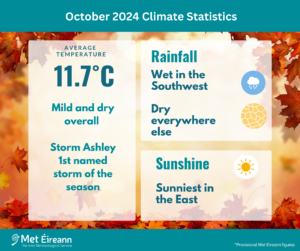
October 2024 Climate Statistics
October 2024 was a mild month everywhere. It was relatively dry for most of the country, apart from the Southwest, which saw above average rainfall. The weather patterns fluctuated between periods of high pressure dominance and Atlantic low pressure dominance. The first week began mostly dry with high pressure to the north in control. As the week progressed high pressure slowly pulled away to the east allowing low pressure to encroach from the west. This brought up a warm moist tropical maritime air mass from the south, along with some pulses of intense thundery rainfall, particularly affecting the Southwest. The second week began with low pressure to the south pushing bands of rain or showers over the country. As the week progressed the active low pressure systems stayed to the south and pressure rose over Ireland, bringing drier and sunnier conditions in a cooler Polar maritime air mass. The third week saw high pressure pulling away to the east again allowing a more mobile westerly regime to develop. A powerful North Atlantic jet stream steered a rapidly intensifying deep area of low pressure, named storm Ashley by Met Éireann, close to the Northwest of the country on Sunday 20th. This brought the windiest period of the month along with some coastal flooding due to the added factor of high spring tides. A mobile westerly airflow continued for most of the fourth week, bringing bands of rain or showers at times interspersed with dry periods. The rain was heavy at times, especially in the West on Thursday 24th. The month finished mostly dry, cloudy and mild with high pressure in control.
Rainfall: Driest in the Northwest, Midlands and East. Wettest in the Southwest
The majority of monthly rainfall totals across the country were below their 1981-2010 Long-Term Average (LTA). Percentage of monthly rainfall values ranged from 53% at both Malin Head, Co Donegal (64.3 mm) and Oak Park, Co Carlow (49.7 mm) to 115% (202.8 mm) at Valentia Observatory, Co Kerry. Monthly rainfall totals ranged from 47.8 mm (61% of its LTA) at Dublin Airport to 202.8 mm (115% of its LTA) at Valentia Observatory, Co Kerry. The highest daily rainfall total was 54.2 mm at Sherkin Island, Co Cork on Saturday 5th (its highest daily fall in October on record (record length 52 years)). The number of rain days* ranged from 16 days at Casement Aerodrome, Co Dublin to 26 days at a few stations. The number of wet days* ranged from 10 days at Oak Park, Co Carlow to 21 days at Valentia Observatory, Co Kerry, Knock Airport and Newport, Co Mayo. The number of very wet days* ranged from zero days at Dunsany, Co Meath to 6 days at Valentia Observatory, Co Kerry. The majority of stations, away from the Southwest, had their driest October for 6-8 years.
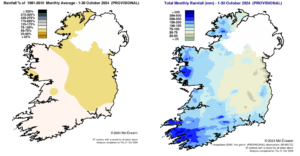
Rainfall % of 1981 – 2010 Monthly Average for October 2024 (Provisional) Total Monthly Rainfall (mm) for October 2024 (Provisional)
Temperature: Mild everywhere
All mean air temperatures across the country were above their LTA for the month. Deviations from mean air temperature ranged from 0.6 °C at Markree, Co Sligo (10.3 °C mean temperature), Ballyhaise, Co Cavan (10.7 °C mean temperature) and Shannon Airport, Co Clare (11.7 °C mean temperature) to 1.5 °C (11.7 °C mean temperature) at Phoenix Park, Co Dublin. Mean temperatures for the month ranged from 10.1 °C (1.2 °C above its LTA) at Knock Airport, Co Mayo to 12.8 °C (0.7 °C above its LTA) at Sherkin Island, Co Cork. The month’s lowest temperatures were recorded on Friday 11th. The lowest air minimum was reported at Moore Park, Co Cork with a temperature of -1.6 °C and the lowest grass minimum was reported at Mount Dillon, Co Roscommon with -6.3 °C. The highest maximum was reported on Wednesday 16th at Athenry, Co Galway with a temperature of 19.1 °C. More than half of stations reported ground frost. The number of days with ground frost ranged from zero days at a few stations to 11 days at Mount Dillon, Co Roscommon. Six stations reported air frost. The number of days with air frost ranged from zero days at most stations to 4 days at Mount Dillon, Co Roscommon.
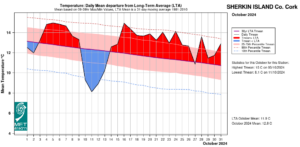
Sherkin Island, Co Cork Temperature: Daily mean departure from LTA for October 2024 based on 09-09hr Max/Min values.
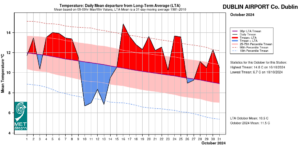
Dublin Airport, Co Dublin Temperature: Daily mean departure from LTA for October 2024 based on 09-09hr Max/Min values.
Sunshine: Sunniest in the East
Nearly all available sunshine totals were above their LTA. Percentage of monthly sunshine values ranged from 106% (monthly sunshine total of 96.1 hours) at Shannon Airport, Co Clare to 114% (the month’s highest monthly sunshine total of 116.4 hours) at Casement Aerodrome, Co Dublin. Monthly sunshine totals were lowest at Valentia Observatory, Co Kerry with 67.3 hours (No LTA comparison*). The highest number of daily sunshine hours recorded this month was 10.1 hours at Johnstown Castle, Co Wexford on Friday 11th. The number of dull days* ranged from 8 days at both Valentia Observatory, Co Kerry and Casement Aerodrome, Co Dublin to 11 days at both Belmullet, Co Mayo and Cork Airport, Co Cork.
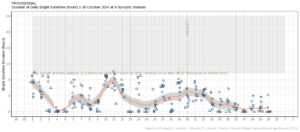
Hours of Bright Sunshine observed at nine stations for each day of the month of October 2024, grouped by province relative to the highest number of hours possible by end of month (shaded box)
Wind: Storm force winds reported during storm Ashley
Monthly mean wind speeds ranged from 5.6 knots (10.4 km/h) at Moore Park, Co Cork to 15.5 knots (28.7 km/h) at Malin Head, Co Donegal. Gales were reported on the 5th, 12th, 18th, 19th and 20th with strong gales and storm force winds reported on Sunday 20th during storm Ashley. Gales were reported at fifteen stations and strong gales were reported at six stations on Sunday 20th during storm Ashley. The number of days with gales ranged from zero days at a few stations to 3 days at Roche’s Point, Co Cork. Storms force winds were reported at both Mace Head, Co Galway and Belmullet, Co Mayo on Sunday 20th during storm Ashley. The month’s highest 10-minute mean wind speed was reported at both Mace Head, Co Galway and Belmullet, Co Mayo on Sunday 20th with 54 knots (100 km/h). The highest gust was 74 knots (137 km/h) reported at Mace Head, Co Galway also on Sunday 20th during storm Ashley. Five stations recorded their highest October gust on record on Sunday 20th during storm Ashley (record lengths between 13 and 27 years). These were Mace Head, Co Galway with 74 knots (137 km/h), Newport, Co Mayo with 69 knots (128 km/h), Athenry, Co Galway with 51 knots (95 km/h), Finner, Co Donegal with 59 knots (109 km/h) and Knock Airport, Co Mayo with 65 knots (120 km/h).
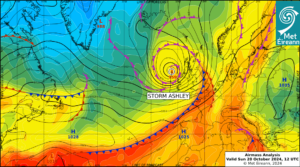
Airmass Analysis chart 12 UTC 20 October 2024: Storm Ashley passes close to the Northwest coast of Ireland bringing storm force winds.
The full report is available here.

Extreme values for October 2024 at synoptic stations
*Issued by Met Éireann on Monday 4th November 2024. This report is based on available preliminary data from 25 principal weather stations operated by Met Éireann. Synoptic station data is midnight to midnight UTC. Long-Term Averages (LTAs) and “average” refer to the period 1981-2010 unless stated. A rain day is a day on which 0.2 mm or more of rainfall is measured. A wet day is a day with 1.0 mm or more of rainfall. A dull day is a day with less than 0.5 hours of sunshine. A very wet day is a day with 10.0 mm or more of rainfall. Climatological dry periods – An absolute drought is a period of 15 or more consecutive days to none of which is credited 0.2 mm or more of precipitation. A partial drought is a period of at least 29 consecutive days, the mean daily rainfall of which does not exceed 0.2 mm. A dry spell is a period of 15 or more consecutive days to none of which is credited 1.0 mm or more of precipitation (i.e. daily tot < 1.0 mm). A heatwave occurs where there are 5 consecutive days or more with maximum temperature over 25°C (that is, a daily maximum screen air temperature > 25° C). The Island of Ireland dataset is 125 years long and runs between 1900 and 2023. For this dataset the long term averages from the 1961-1990 reference period are used for comparison as is standard for long-term climate change assessments. *Sunshine data is from the Autosol Network. LTAs for these sites are currently not used for comparison purposes. For more information, contact Met Éireann at 01-8064200 or e-mail: enq@met.ie